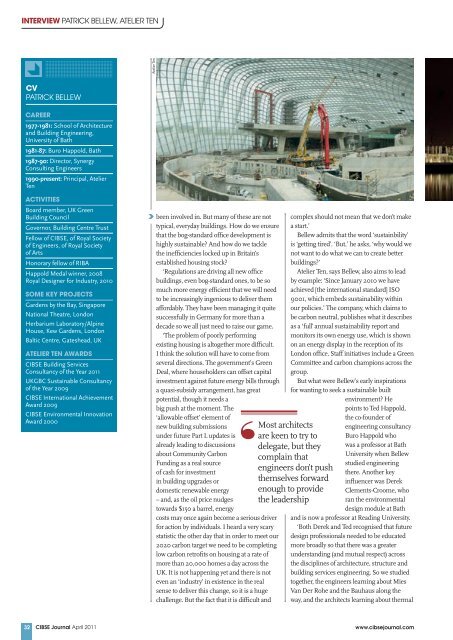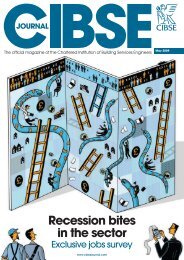Create successful ePaper yourself
Turn your PDF publications into a flip-book with our unique Google optimized e-Paper software.
IntervIew PAtrick Bellew, Atelier ten<br />
Cv<br />
PAtrick Bellew<br />
Career<br />
1977-1981: School of Architecture<br />
and Building Engineering,<br />
University of Bath<br />
1981-87: Buro Happold, Bath<br />
1987-90: Director, Synergy<br />
Consulting Engineers<br />
1990-present: Principal, Atelier<br />
Ten<br />
aCtIvItIes<br />
Board member, UK Green<br />
Building Council<br />
Governor, Building Centre Trust<br />
Fellow of <strong>CIBSE</strong>, of Royal Society<br />
of Engineers, of Royal Society<br />
of Arts<br />
Honorary fellow of RIBA<br />
Happold Medal winner, 2008<br />
Royal Designer for Industry, 2010<br />
some key projeCts<br />
Gardens by the Bay, Singapore<br />
National Theatre, London<br />
Herbarium Laboratory/Alpine<br />
House, Kew Gardens, London<br />
Baltic Centre, Gateshead, UK<br />
atelIer ten awards<br />
<strong>CIBSE</strong> Building Services<br />
Consultancy of the Year 2011<br />
UKGBC Sustainable Consultancy<br />
of the Year 2009<br />
<strong>CIBSE</strong> International Achievement<br />
Award 2009<br />
<strong>CIBSE</strong> Environmental Innovation<br />
Award 2000<br />
32<br />
Atelier Ten<br />
been involved in. But many of these are not<br />
typical, everyday buildings. How do we ensure<br />
that the bog-standard office development is<br />
highly sustainable? And how do we tackle<br />
the inefficiencies locked up in Britain’s<br />
established housing stock?<br />
‘Regulations are driving all new office<br />
buildings, even bog-standard ones, to be so<br />
much more energy efficient that we will need<br />
to be incre<strong>as</strong>ingly ingenious to deliver them<br />
affordably. They have been managing it quite<br />
successfully in Germany for more than a<br />
decade so we all just need to raise our game.<br />
‘The problem of poorly performing<br />
existing housing is altogether more difficult.<br />
I think the solution will have to come from<br />
several directions. The government’s Green<br />
Deal, where householders can offset capital<br />
investment against future energy bills through<br />
a qu<strong>as</strong>i-subsidy arrangement, h<strong>as</strong> great<br />
potential, though it needs a<br />
big push at the moment. The<br />
‘allowable offset’ element of<br />
new building submissions<br />
under future Part L updates is<br />
already leading to discussions<br />
about Community Carbon<br />
Funding <strong>as</strong> a real source<br />
of c<strong>as</strong>h for investment<br />
in building upgrades or<br />
domestic renewable energy<br />
– and, <strong>as</strong> the oil price nudges<br />
towards $150 a barrel, energy<br />
costs may once again become a serious driver<br />
for action by individuals. I heard a very scary<br />
statistic the other day that in order to meet our<br />
2020 carbon target we need to be completing<br />
low carbon retrofits on housing at a rate of<br />
more than 20,000 homes a day across the<br />
UK. It is not happening yet and there is not<br />
even an ‘industry’ in existence in the real<br />
sense to deliver this change, so it is a huge<br />
challenge. But the fact that it is difficult and<br />
complex should not mean that we don’t make<br />
a start.’<br />
Bellew admits that the word ‘sustainbility’<br />
is ‘getting tired’. ‘But,’ he <strong>as</strong>ks, ‘why would we<br />
not want to do what we can to create better<br />
buildings?’<br />
Atelier Ten, says Bellew, also aims to lead<br />
by example: ‘Since January 2010 we have<br />
achieved [the international standard] ISO<br />
9001, which embeds sustainability within<br />
our policies.’ The company, which claims to<br />
be carbon neutral, publishes what it describes<br />
<strong>as</strong> a ‘full’ annual sustainability report and<br />
monitors its own energy use, which is shown<br />
on an energy display in the reception of its<br />
London office. Staff initiatives include a Green<br />
Committee and carbon champions across the<br />
group.<br />
But what were Bellew’s early inspirations<br />
for wanting to seek a sustainable built<br />
environment? He<br />
points to Ted Happold,<br />
the co-founder of<br />
engineering consultancy<br />
Buro Happold who<br />
w<strong>as</strong> a professor at Bath<br />
University when Bellew<br />
studied engineering<br />
there. Another key<br />
influencer w<strong>as</strong> Derek<br />
Clements-Croome, who<br />
ran the environmental<br />
design module at Bath<br />
and is now a professor at Reading University.<br />
‘Both Derek and Ted recognised that future<br />
design professionals needed to be educated<br />
more broadly so that there w<strong>as</strong> a greater<br />
understanding (and mutual respect) across<br />
the disciplines of architecture, structure and<br />
building services engineering. So we studied<br />
together, the engineers learning about Mies<br />
Van Der Rohe and the Bauhaus along the<br />
way, and the architects learning about thermal<br />
Most architects<br />
are keen to try to<br />
delegate, but they<br />
complain that<br />
engineers don’t push<br />
themselves forward<br />
enough to provide<br />
the leadership<br />
<strong>CIBSE</strong> <strong>Journal</strong> April 2011 www.cibsejournal.com







